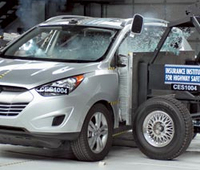IIHS: Vehicles That Earn Good Test Ratings for Side-Impact Protection Greatly Reduce Risk of Dying for Drivers in Real-World Crashes - VIDEO ENHANCED
 |
SEE ALSO: IIHS Announces 66 Winners of 2011 Top Safety Pick Award
ARLINGTON, VA - January 26, 2011: Drivers of vehicles that perform well in the Insurance Institute for Highway Safety's side-impact crash test are much less likely to die in a real-world left-side crash than drivers of vehicles that do poorly, a new analysis finds. The study includes only passenger vehicles with side airbags, demonstrating that airbags, while crucial, are far from the whole story in side crash protection.
After controlling for driver age and gender and vehicle type and weight, a driver of a vehicle rated good for driver protection in a side impact is 70 percent less likely to die in a left-side crash compared with a driver of a vehicle rated poor. A driver of a vehicle rated acceptable is 64 percent less likely to die, and a driver of a vehicle rated marginal is 49 percent less likely to die.
Click PLAY to watch video
These probabilities were calculated using ratings that reflect driver protection only and differ from the Institute's published ratings, which reflect protection for both the driver and a passenger in back. The study looked mainly at driver death risk because federal crash statistics don't contain the information needed to calculate passenger risk the same way. The researchers computed driver-only ratings for vehicles in the study using the same method the Institute normally uses to rate models that don't have back seats.
"This was our first look at how our ratings correlate with actual crash data since we started side tests in 2003, and the numbers confirm that these are meaningful ratings," says Institute chief research officer David Zuby. "Vehicles with good side ratings provide occupants with far more protection than vehicles that do poorly in our test."
Studies of frontal crashes have shown similar results: Drivers of vehicles with good ratings in the Institute's frontal offset crash test are much less likely to die in frontal crashes.
Side-impact crashes accounted for 27 percent of passenger vehicle occupant deaths in the United States in 2009. Such crashes can be particularly deadly because the sides of vehicles have relatively little space to absorb energy and shield occupants.
The ultimate goal of the Institute's testing program is to encourage automakers to produce safer vehicles. Knowing that consumers consult the ratings before buying, manufacturers design cars and trucks with the Institute's tests in mind. As a result, 78 percent of current vehicle designs that have been tested have good side ratings, compared with only about a third of vehicles tested in the program's first two years.
Such improvement is important to the extent it predicts performance in a real-world crash. To gauge how well the test does that, the Institute looked at federal data on side crashes from 2000 to 2009. Only crashes involving Institute-rated vehicles with standard side airbags to protect both the head and torso were included in the analysis.
By limiting the study to vehicles with side airbags, the researchers were able to bring other factors such as structure into sharper focus. Previous research has shown the importance of side airbags, and no vehicle without head-protecting side airbags has ever earned a good rating from the Institute.
"We knew that our ratings would encourage manufacturers to add head-protecting side airbags, which would save lives," Zuby says. "It's great to see that other aspects of our evaluation, such as encouraging strong side structures, resulted in so much additional protection."
In the Institute test, a vehicle is hit on the driver side by a deformable barrier weighing 3,300 pounds and traveling at 31 mph. The barrier's height and shape are designed like the front of a typical SUV or pickup.
Ratings are based on injury measures recorded on dummies, head protection, and vehicle intrusion during crash tests. In addition to looking at overall driver protection, researchers also looked at these components individually. They found that a vehicle's structure rating was by far the best predictor of fatality risk.
A key difference between the Institute's side crash test and one the government runs is the Institute's SUV-like barrier. The National Highway Traffic Safety Administration uses a lower barrier designed when the majority of vehicles on the road were cars.
Another important distinction is the type of dummy used. Until recently, both dummies used in the government's side barrier test represented average-size men, while the Institute's side test has always used dummies representing small women or 12-year-old children.
The choice of a small female dummy was a first for any consumer information test. The decision was based on the fact that women are more likely than men to suffer serious head injuries in real-world side impacts. Shorter drivers have a greater chance of having their heads come into contact with the front end of the striking vehicle in a left-side crash.


